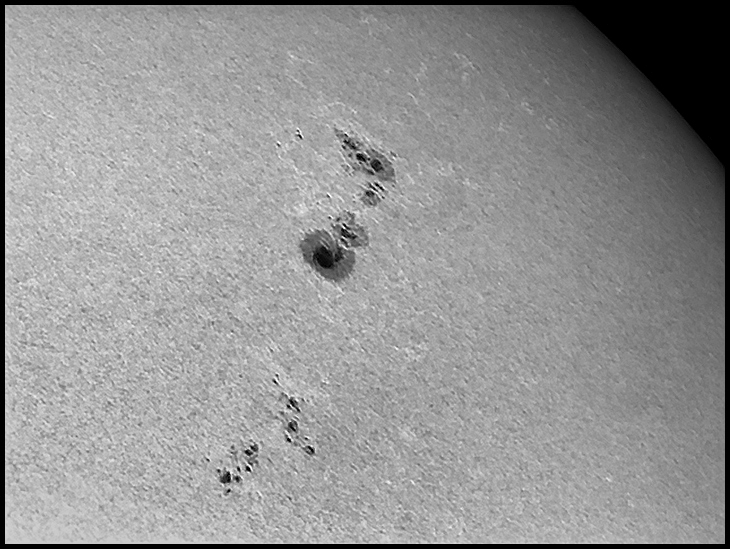| |
06/29/2012. The temperature hit 104°F in Charlotte about the time I was capturing the three clips from which I distilled these two photos of receding active region 1504. No wonder, eh? I'm always amazed we're not incinerated when iI see our local star up close:


The top frame is my first solar image with the AT10RC. I added a full-aperture Baader "AstroSolar" foil filter from AstroZap to the kit (the same sizel that fits the Meade SN10 fits the AT10RC nicely): best 40% of 400 frames, 1.3ms, 6db, gamma=1.00. I used the continuum filter, too. My first attempt was with the snout-mounted Barlow, but the image scale was excessive given poor, high amplitude seeing. (Time out for a quick note to me: the barlow-equipped Chameleon comes to focus in the Maxbright diagonal almost fully racked in; without the Barlow, remove the diagonal and use a 2-inch extension; then the point of best focus is near 4 on the cm scale of the AT's focuser -- either the IR leakage in the continuum filter is moderated by the dielectric mirrors in the AT, or it doesn't matter given the perfectly achromatic, all-reflective system).
No new techniques on the lower image witth the double-stacked Lunt H-a telescope: one clip for disk detail (40% of 400 frames, 10ms, 10db, gamma 0.85); another clip for the limb (40% of 400 frames, 55ms, 10db, gamma 0.85), processed separately. Next time, try gamma 1.00 or 1.10 for prominences.
It only got to 98°F here, but the heat still forced a thermal shutdown of the netbook and later did the same for the Pyramid power supply. I brought the computer inside for a few minutes, restarted it, and then made sure to keep it covered loosely with a white, reflective cloth; I switched to battery power to resolve the second issue. The box with the power supply is already covered in reflective foil, and I had a white shade over it. Add a fan, perhaps?
:: top ::
Except where noted, solar photos are made with a Point Grey Research Chameleon camera behind a Lunt Solar Systems 60mm THa solar telescope double-stacked wtih a 50mm front etalon for an achieved bandwidth of about 0.55 Angstroms. The telescope uses a B600 blocking filter and is mounted piggyback with an Astro-Tech 10-inch Ritchey-Chretien (carefully capped!) on an Astro-Physics Mach1GTO mount. An Acer Aspire One netbook running Point Grey's Flycap software provides camera control and capture services via USB 2.0. Images typically begin as 20 second AVI's captured at 15 fps. 300 frame clips are aligned and stacked using Registax 6 or AVIStack 2.0. The resulting files are processed via wavelet functions in Registax and / or the FocusMagic 3.0.2 deconvolution plug-in in Photoshop CS4. (PixInsight is rapidly supplanting some of those steps.) The imaging train usually includes an Orion "Shorty" 2x barlow screwed into the 1.25-inch prime-focus snout. Exposures are on the order of 4-8 ms with gain set to 10-12 db, or 12-18ms at 0 gain. The barlow is sometimes replaced by an Antares 0.5x telecompressor sandwiched between the 1.25-inch snout and the C-adapter on the PGR Chameleon; this produces a full-disk image (during most of the year) and allows exposures in the 1ms range with slightly less gain. A RoboFocus motor with a timing belt looped around the stock (or, sometimes, a Feathertouch) focus knob enables remote operation.
|

